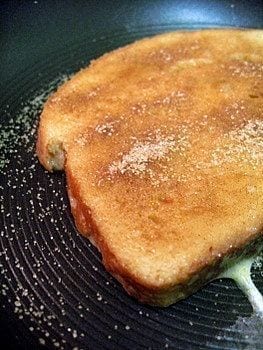When I first received an email from my editor about the newly released bestseller Year of No Sugar: A Memoir, in which a woman recounts her family’s attempt to go sugar- (and artificial sweetener-) free for an entire year, my immediate reaction was to tell her that I wasn’t interested in writing an article about it. “If you’re looking for someone to try this experiment, even for a day,” I said right off the bat, “you’ve got the wrong person. A day without sugar for a confirmed addict like me? Unless it’s a fast day, I’d be cheating within an hour.” Would you like some coffee with that sugar? That pretty much sums up how I, a sworn chocoholic with a mouth full of sweet teeth, enjoy my morning brew. I love cookies and cake with a passion. Splenda? Truvia? Agave? Not for me! I go for the real deal only. What you don’t know can’t hurt you, I reasoned, determined to protect my ignorance. I’d been down this road before. Ever since researching the topic of genetically modified foods (“Feast or Famine,” Issue 54), I haven’t been able to bring myself to buy certain products that were once beloved family favorites. I can do without corn chips for the sake of improving my family’s health. But would I really want to learn about the dangers of sugar and swear it off forever? No, I’d rather hold on to my sugary vice than uncover anything that might threaten it. Eventually, however, curiosity about author Eve O. Schaub’s yearlong experiment got the best of me, and I resigned myself to the assignment. I ordered the book with overnight shipping. Here we go again, I sighed.

But first, a little background. It all began when Eve Schaub happened to see an eye-opening YouTube video of a lecture entitled “Sugar: The Bitter Truth,” given by Dr. Robert Lustig, a pediatric endocrinologist. (Thanks in no small part to Eve Schaub’s book, the video has been watched an astounding 4.2 million times and counting.) Dr. Lustig is a professor at the University of California, San Francisco, and president of the Institute for Responsible Nutrition. So you can’t really label him a quack or accuse him of having no knowledge of the subject. For over an hour he explains in painstaking detail (my eyes still glaze over thinking about the segment on biochemistry) the way that fructose, a sugar found in table sugar, honey, maple syrup, agave and fruit juices, affects our bodies. His conclusion: it’s poison. Here’s a brief summary (you should really thank me for saving you from a lecture-induced nap!) of how it works: When glucose enters the body, most of it is used up by cells and organs before it reaches the liver. The remaining amount that makes it into the liver is easily stored as glycogen. The liver then releases chemicals to signal the brain that it should stop eating. This is as it should be. Glucose, says Dr. Lustig, “is the energy of life.” We’re supposed to eat it. Bon appétit. However, he continues, when fructose enters the body, it all goes straight to the liver. The brain can’t metabolize fructose; only the liver can—and it causes a host of problems.Thirty percent is immediately turned into fat, generating harmful chemicals in the process, and uric acid is increased, causing gout and hypertension. But there’s more bad news. Fructose, unlike glucose, doesn’t suppress ghrelin, the hunger hormone, so you keep on eating. It also doesn’t stimulate insulin production because there’s no receptor for fructose on the beta cells that produce it. This means that leptin, the hormone signaling you’ve had enough, doesn’t reach your brain, so it doesn’t get the message that you already ate that delicious doughnut. Next thing you know, you’re digging into the box for seconds and thirds. Of course, it’s not as though you’re going to keel over from eating a single ice cream cone with sprinkles.

Nonetheless, according to Dr. Lustig, chronic fructose exposure causes metabolic syndrome, a group of risk factors that increase the chance you will develop any of the following conditions: obesity, type II diabetes, lipid problems, hypertension and cardiovascular disease, myocardial infarction, dyslipidemia, pancreatitis, obesity, hepatic dysfunction and fetal insulin resistance. Oh, and should I mention habituation? We crave the stuff even after we ingest it. (Admit it—you know it’s true. You can’t eat just one cookie.) “We all weigh 25 pounds more than we did 20 years ago,” Dr. Lustig declares emphatically. “Every other culture that has adopted the American diet ends up having the same problems with obesity and diabetes.” It seems they’re even performing bariatric surgery on children in China. “There’s an epidemic of obese six-month-olds around the world,” he tells his captivated audience. “We’re all eating more.” Dr. Lustig walks us through some fascinating history. In the 1970s, he explains, the fluctuating price of food was greatly stabilized by Richard Nixon for political reasons. In 1975, high-fructose corn syrup (HFCS), invented in 1966 in Japan, was introduced to the American market. HFCS is half the price of sugar—so cheap that it soon found its way into everything: buns, pretzels, barbecue sauce. Food manufacturers began to add it to all their processed foodstuffs. And here’s another reason. In 1982, the United States Department of Agriculture, the American Medical Association and the American Heart Association advised Americans to reduce their fat intake in an effort to curb heart disease. LDL (low-density lipoprotein, a.k.a. “bad” cholesterol), the big dietary baddie, had been discovered in the late 1970s and was shown to correlate with cardiovascular disease.
Dietary fat, scientists learned, raised LDL. Thus began the trend toward low-fat diets, but as companies began to remove fat from their products, the results tasted like cardboard. The solution? Adding HFCS to make them more palatable. Today, Lustig says, every American consumes 63 pounds of it a year. Another negative development was the elimination of fiber from our diets. Foods that contain fiber have to be cooked longer and have a shorter shelf life. “Bye-bye, fiber,” said the fast-food industry. While overall fat intake was greatly reduced, cardiovascular disease, stroke and other related health problems continued to rise. What scientists didn’t know at the time was that up to 30 percent of fructose is metabolized into fat, so a low-fat, high-fructose diet isn’t really low-fat. In other words, when you ingest fructose, you’re eating fat. Still, Dr. Lustig proclaims, “It’s not fat that is causing obesity! We’ve been eating more and more sugar as the decades pass”—and the scary thing is that we’re not even aware of most of it. In his PowerPoint presentation Dr. Lustig demonstrates how the typical bottle of Coca-Cola has grown over the past 100 years, from 6.5 ounces in 1915 to today’s 20-ounce bottle. Moreover, soft drinks contain sodium, which makes you thirsty, so you reach for more. Coca-Cola also contains caffeine, a diuretic that doubles the thirstinducing effect. But guess why you didn’t know about the sodium? Its taste is masked by sugar—lots of it. You’re probably wondering at this point about fruit. It’s “kosher,” according to Dr. Lustig. “G-d created it together with the antidote.” Wherever fructose occurs in nature, it’s accompanied by lots of healthy fiber. That’s why fruit is okay.

The fiber limits how much fructose you absorb and provides essential nutrients and macronutrients to help your liver function. The fiber also gives you the satiety signal faster, minimizing the dangers. I was pretty horrified when Dr. Lustig revealed the reason behind the worldwide epidemic of obesity among babies. According to the nutritional information on the back of any can of infant formula, it contains corn syrup solids and sucrose—a veritable “baby milkshake,” as he refers to it. Citing various studies, he explains that the earlier you expose children to sweet foods, the more they’ll crave them later. And the connection goes back even earlier: “The more sugar a mother ingests during pregnancy, the more [sugar] crosses through the placenta, causing developmental programming and changing the child’s adiposity even before he is born.” Yikes! So why, you are wondering, is fructose so prevalent in our diets? According to Dr. Lustig, the FDA will only regulate acute toxins, not chronic ones like fructose. “The liver doesn’t get sick after one fructose meal. It gets sick after 1,000 fructose meals.” And the USDA won’t regulate fructose in the food industry either, for financial reasons. It is therefore up to us to limit fructose in our diets for the sake of our health.
While some of you may be rolling your eyes, his argument is very convincing in light of the numerous studies he cites and the information he provides. Eve Schaub says she was sold as soon as she heard it: “The morning I watched that video my brain caught on fire.” Dr. Lustig’s compelling presentation convinced her that “sugar is everywhere, it’s making us fat and sick, and almost no one realizes it.” All of which inspired her to embark on her grand experiment: a year without sugar. For the Schaub family—Eve, her husband, Steve, 11-year-old Greta and six-year-old Ilsa—2011 would be memorable indeed. The Vermont-based family began to scour the ingredient lists on packaged foods in search of the enemy: sugar in its pure form, as well as HFCS, crystalline fructose, maple syrup, honey, molasses, evaporated cane juice and artificial sweeteners. In fact, the Schaubs became sugar-sleuthing experts. So inescapable was hidden sugar content in the supermarket that it prompted them to start cooking more at home. Think it’s simple to avoid added sugar? It’s nearly impossible. Ketchup. Mayonnaise. Bread. Crackers. These all became no-nos. A spoonful of sugar may help the medicine go down, but did you know that “standard medicine cabinet items such as fever reducers and cough drops have been essentially transformed into candy”? (Eva allowed her family to use these products when necessary.) Throughout the book she details the difficulties she encountered while grocery shopping, eating out in restaurants and attending social functions, where the family felt somewhat isolated. And analyzing her children’s breakfast and school lunch menu shocked her; that’s how much sugar they contained.
Every family member was allowed one regular exception that contained a small amount of sugar. Eve chose a glass of red wine; her husband opted for a can of diet soda; and she convinced her girls to choose fruit jam. Once a month the Schaubs enjoyed a voted-upon dessert, which they discovered tasted less appealing to their sugar-sensitive tongues as time wore on. And in addition to their changing palates, Eve found that her girls experienced fewer colds and coughs over the course of the year, and that the entire family had better gastrointestinal functioning and fewer energy crashes. Most interesting to me, though, were some of Eve’s observations about our culture’s relationship to food and how we celebrate occasions with unhealthy doses of it. Take, for example, how easily we dole out sweets to our children. “I realized it had become so cheap and easy to hand a child a treat that inflation had set in. No longer is it sufficient for the teacher to bring the kids a doughnut—there has to be a pile of candy next to it.” Sweets are also used as an expression of love. But unfortunately, “the body can’t tell the difference between the high-fructose corn syrup in processed foods like ketchup and Grandma’s lovingly baked molasses cookies.” After I read Eve’s book (which did frighten me, just as I feared), watched Dr. Lustig’s lecture and read some criticism of his arguments, it was time to process what I’d learned. I decided that I wasn’t entirely convinced either way—but I started to pay attention.
Were there really two cups of sugar in my challah recipe? Wow! Two cups of sugar baked into five loaves means that every Shabbos we’re each consuming several tablespoons of sugar before we even get to the fish course! Then there’s our favorite olive dip, which lists sugar as the third ingredient—even before the mayo, which, I learned from Eve’s book, contains sugar too! My favorite brand of yogurt should probably be considered ice cream. And let’s not even mention the bottle of orange juice my kids go through every week. Regardless of whether or not fructose is really a toxin, excessive consumption can’t be a good thing. While I can’t promise that I’ll be avoiding sugar entirely (Shavuos is coming up, and no one likes caramel cheesecake more than I do), this morning I put one teaspoon less of it in my coffee. Maybe I’ll try to make challah with one cup of sugar instead of two. And homemade olive dip tastes just as good as the store-bought version. After all, there’s nothing sweeter than good health.




